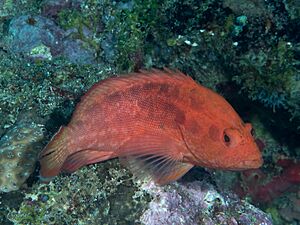Cephalopholis spiloparaea facts for kids
Quick facts for kids Cephalopholis spiloparaea |
|
|---|---|
 |
|
| Conservation status | |
| Scientific classification | |
| Synonyms | |
|
The strawberry hind (scientific name: Cephalopholis spiloparaea) is a cool fish that lives in the ocean! People also call it the strawberry rock cod, strawberry cod, or orange rock cod. It's a type of grouper, which is a large group of fish that includes sea basses. You can find these fish swimming in the warm waters all across the Indo-Pacific region.
Contents
What Does the Strawberry Hind Look Like?
The strawberry hind has a body that is about 2.6 to 3 times longer than it is deep. It has a dorsal fin (the one on its back) with 9 strong spines and 14 to 16 soft rays. Its anal fin (on its belly, near the tail) has 3 spines and 9 to 10 soft rays.
Fins and Scales
Its pectoral fins (the ones on its sides, like arms) are much longer than its pelvic fins (on its belly, closer to the head). The tail fin, called the caudal fin, is nicely rounded. If you were to count the scales along its side, you'd find about 47 to 53 scales in its lateral line (a special line of scales that helps fish sense vibrations).
Colors and Patterns
This fish is usually a pale reddish-orange color. It has darker red or brownish-red spots and blotches all over its body, like a cool camouflage pattern! You might also see faint pale spots on its head, body, and fins.
The tail fin is usually the same color as its body. However, some strawberry hinds from the Comoros Islands have yellowish tails with a bluish-white band near the edges. The edges of its anal fin and sometimes its dorsal fin can also be bluish. Sometimes, you can even spot 8 faint dark saddle-like blotches along the base of its dorsal fin. This fish can grow up to about 30 centimeters (about 12 inches) long.
Where Do Strawberry Hinds Live?
The strawberry hind lives in a huge area called the Indo-Pacific. This stretches all the way from the coasts of East Africa, like Kenya and Mozambique, across the Indian Ocean, and into the Pacific Ocean. You can find them as far east as French Polynesia and Pitcairn Island.
Their Ocean Home
They live as far north as the Ryukyu Islands in Japan and as far south as the Rowley Shoals in Western Australia. They also live near Heron Island in the southern part of Australia's famous Great Barrier Reef.
Strawberry Hind's Home and Habits
Strawberry hinds mostly live around islands. They love to hang out in coral reefs, especially in deeper waters, usually more than 40 meters (about 130 feet) deep. In these deep reef areas of the Indo-Pacific, the strawberry hind is one of the most common types of grouper you'll find!
Family Life and Food
These fish are known to live in groups called harems, where one male fish is in charge of several females. They are active hunters and mostly eat crabs and other crustaceans (like shrimp). They usually look for food at night or very early in the morning, right around sunrise or sunset.
Are Strawberry Hinds Fished?
The strawberry hind is not a major target for big fishing industries. This is good news because the deep waters where they live help protect them from being overfished. So, they are not in too much danger from humans catching too many of them.


